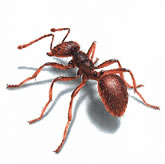
Appearance:
Among the largest ants, from 1/4- to 3/8-inch long. The most common species is black, but some have reddish or yellowish coloration. Workers have large mandibles.
Habit:
Resides both outdoors and indoors in moist, decaying or hollow wood. They cut "galleries" into the wood grain to provide passageways for movement from section to section of the nest. Can leave "sawdust" behind that provides clues to nesting location.
Diet:
Does not eat wood, but will feed on nearly anything people eat—particularly sweets and meats. Will also feed on other insects.
Reproduction:
Queen lays 15 to 20 eggs the first year and up to 30 eggs the second year. Eggs complete their life cycle in about 60 days. Worker ants can live up to seven years, while a queen may live up to 25 years.
Carpenter ants are large insects, ranging in size from 1/2-inch to one inch in length. They are most commonly black, but some carpenter ants exhibit both red and black coloration. They are common in many parts of the world.
Carpenter ants are active year-round and can be found both indoors and outside. It is also common for carpenter ants to have to have an outdoor nest, appearing indoors only to obtain water or food.
In nature, carpenter ants live in dead trees, rotting logs and tree stumps. They tend to build nests in deteriorating wood, but their colonies may extend to healthy wood, as well. In urban surroundings, carpenter ants will make their homes in telephone poles, house porch pillars and roofs, windowsills and wood that comes in contact with soil. Carpenter ants prefer to burrow into damp wood rather than dry wood.
Carpenter ants burrow to provide a nest for their colonies, and over a long period of time, their burrowing may compromise a structure. In controlling an infestation of carpenter ants, it is necessary to first find the nest. Once found, it can be removed or treated chemically. All moisture conditions that the ants found conducive must be corrected.
It is advisable to seek professional help in containing carpenter ant infestations, as incorrect procedures may allow the colony to "rebound" when surviving member resume their burrowing and foraging.
Carpenter Ant
Appearance:
Light brown to black with appendages lighter than rest of the body. About 1/10-inch long. Parallel lines on head and thorax with a 12-segment antennae.
Habit:
Invades buildings while foraging for food throughout the year. Nests are outdoors under stones, along curbs or in cracks of pavement. Can nest indoors in walls and under floors.
Diet:
Omnivorous. Will eat many things, but prefers greasy and sweet foods.
Reproduction:
Queen produces five to 20 eggs per day; brood develops in about 40 days; young go through three larval stages.
Pavement ants measure approximately 1/8-inch in length and have brown to black bodies, pale legs and antennae. These ants are found throughout the Eastern United States and are major pests in the Upper Midwest. Pavement ants earned their name because they nest in cracks in driveways and under sidewalks, piling the resulting dirt in a mound on top of the pavement.
Pavement ants also dwell in the undersides of logs, bricks, stones, patio blocks and boards. Pavement ants may also nest under mulching or open soil close to building foundations. They rarely nest indoors, but when pavement ants do enter buildings, they are seen under floors, inside insulation and within walls.
Pavement ants undergo complete metamorphosis, passing through the egg, larval and pupal stages before becoming mature adults. Unlike other ants, pavement ants mate for many days, and the period of their mating is lengthened by heat and humidity. Mating swarms can include an extremely large number of reproductives.
A typical colony of pavement ants includes multiple queens and numerous workers. A queen establishes a new colony of pavement ants by laying eggs. Pavement worker ants then tend the queen's brood until they develop into adults. During their development, broods are transferred from location to location to protect them from fluctuations in moisture and temperature.
Pavement ants will feed on a wide variety of foods, including meats, grease, live and dead insects, seeds and honeydew from aphids. They prefer to eat greasy foods, and can eat most foods consumed by humans. They forage for food up to thirty feet from their colonies and set up trails to food sources from their nests. Pavement ant workers enter houses to forage and can become a nuisance when large groups infest a kitchen or garden patio. They are not aggressive, but they can sting and bite.
The nests of pavement ants are difficult to locate, so the most efficient way to manage an infestation is to contact a Family Pest Control professional.

Pavement Ant
--------------------------------------------------------------------------------------------------------------
Always ready to serve You - 301-731-2024
Home Privacy Policy Family Careers Feedback Pest Control Termite Control Commercial Contact Us Links
